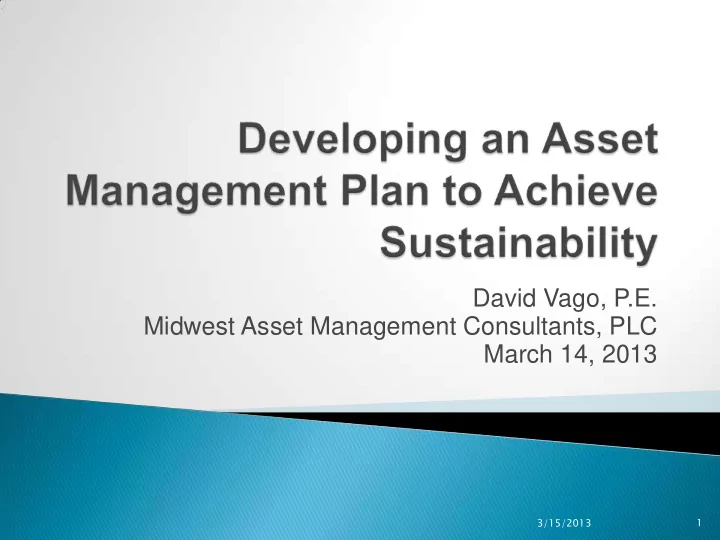

David Vago, P.E. Midwest Asset Management Consultants, PLC March 14, 2013 3/15/2013 1
3/15/2013 2
3/15/2013 3
The CONDITION of each PIECE OF EQUIPMENT is evaluated using five criteria: • Physical condition based on visual inspection – Almost as reliable as predictive maintenance, especially when combined with other factors. • Age factor – Evaluate condition based on useful life, frequency of operation and whether rebuilt. • O&M Protocols – Completeness of manuals, records and SOPs • Repair history – A refinement on Reliability. • Current Operational Status – Out of service and not repairable or operating with no discernible problems? 3/15/2013 4
Equipment Name: Process Pump #1 Asset ID PI 1 Date: March 19, 2009 Classify the equipment based on the following criteria 1 Frequently Operated Major = 1 Frequently Operated Minor = 2 Frequently Operated rebuilt/reconditioned = 3 Weighting Factor Infrequently operated = 4 5 4 3 2 1 Very High High Moderate Low Very Low Physical Condition (Based Very Poor Poor Fair Good Very Good 1 x on visual inspection) (Condition Grade 5) (Condition Grade 4) (Condition Grade 3) (Condition Grade 2) (Condition Grade 1) Greater than 80% of Age betw een 60% and Age betw een 40% and Age betw een 20% and Age less than 20% of Age Factor 1 useful life 80% of useful life 60% of useful life 40% of useful life useful life x Written/online, but not Written/online, but not Complete, w ritten/online, Complete, w ritten/online, O&M Protocols 1 None complete, not current or complete, not current or current, but not easily current, and easily x location unknow n not easily accessible accessible accessible Very Poor (Repaired more Moderate (Repaired 5 to Poor (Repaired 10 to 15 Good (Repaired 1 to 5 Very Good (Not repaired Repair history 1 than 15 times in the last 10 times in the last 10 x times in the last 10 years) times in the last 10 years) in the last 10 years) 10 years) years) Current Operational Not operational and not Operational but needs to Operational but needs Operational w ith minimal 1 No operational problems x Status repairable be rebuilt or upgraded some restoration problems Probability of Failure (P) 1.0 Very Low 3/15/2013 5
• Pipeline assessment and Certification Program • NAASCO - National Association of Sewer Service Companies 3/15/2013 6
• The recording should fully document the inspection with suitable quality video and audio. • The inspection should provide an unobstructed view of the entire pipe and use reverse set-ups where necessary to complete the inspection. • Pipe must be adequately cleaned to see any structural defects or construction features. • Care must be exercised to insure acceptable lighting is provided, particularly in larger diameter pipe. 3/15/2013 7
Codes organized into 4 Families: • Structural Defects – 13 groups • Operational and Maintenance Defects – 6 groups • Construction Features – 4 groups • Other 3/15/2013 8
Grade 5 Major Defects that should be reviewed and prioritized for repair or reassessment Grade 4 Significant Defects that will likely change over time and should be monitored Grade 3 Moderate Defects but little change in condition expected Grade 2 Minor Defects Grade 1 Excellent structural condition 3/15/2013 9
An enterprise that is serious about • sustainability will use its sustainability report to define criticality in order to arrive at Business Risk 3/15/2013 10
Meeting the needs of the present without compromising the ability of future generations to meet their own needs • Based on performance in three key areas (Triple Bottom Line). o Economic o Environmental o Social 3/15/2013 11
• If an Asset Management “program” is intended to help clients achieve sustainability, how will you know when you’ve achieved it? • What do you measure and report on to show you are sustainable? 3/15/2013 12
1. Executive Summary – Statement on the significance of sustainability to the organization 2. Organizational profile – How is the utility organized? Who are the directors and managers? 3. Facility Profile – Describe the process and a site plan. Include an aerial photo if one is available. Consider performing a Vulnerability Assessment or updating an existing one. 3/15/2013 13
4. Environmental Considerations a) Emissions and Waste b) Resource Use c) Resource Recovery and Production d) Sustainable Materials and Material Use e) Facility Footprint 5. Economic Considerations a) General b) Cash flow c) Balance Sheet 6. Social Considerations a) Workforce b) Special Stakeholder Considerations 3/15/2013 14
7. Technical Considerations a) Reliability and Redundancy b) Collection System Integrity c) Future Expandability and Optimization d) Resiliency and Adaptability 8. Future Recommendations 3/15/2013 15
• The sustainability plan defines your mission ◦ What are your environmental priorities? ◦ What are the expectations of your customers? ◦ How will you pay for it? • Once you know your mission then the criticality of each asset can be evaluated on a scale of 1 (low importance) to 5 (mission critical) 3/15/2013 16
ASSET RANKING • The Business Risk Score for any given asset is derived by multiplying the condition score by the criticality score. • Results in a score between 1 and 25 3/15/2013 17
Work Priority Matrix 25 20 15 10 5 5 20 16 12 8 4 4 Criticality 15 12 9 6 3 3 10 8 6 4 2 2 5 4 3 2 1 1 5 4 3 2 1 Probability of Failure High Priority (16 - 25) Medium Priority (6 - 15) Low Priority (1 - 5) 3/15/2013 18
3/15/2013 19
Questions? 3/15/2013 20
Recommend
More recommend